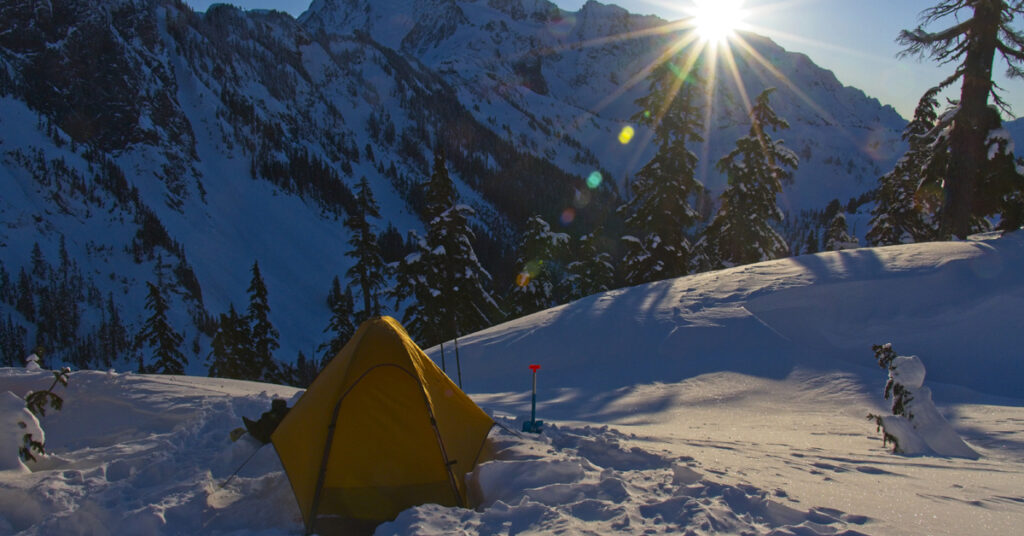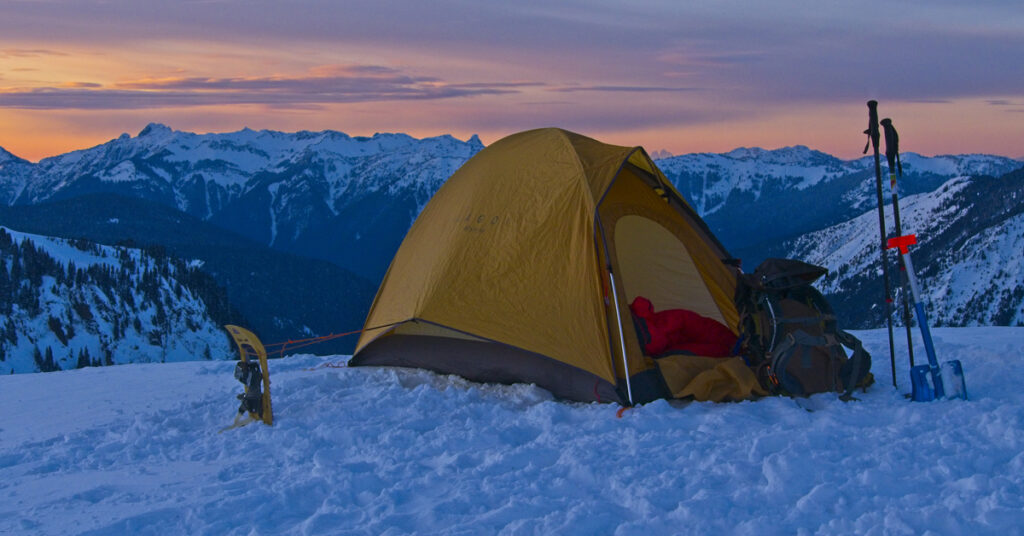Here are 12 basic tips for having a warm night’s sleeping while sleeping out on the snow or ice.
1. Pick a sheltered campsite. Camp on the leeward side of ridges and mountains or near large boulders that break the wind. Avoid camping near water or in drainage areas where cold air collects. For me, views take priority, so generally, I don’t always pick the most sheltered site. To stay warm, I rely on other strategies (listed below).

2. Fluff up your sleeping bag: Always shake out and fluff up your sleeping bag as much as possible when you set up camp. The loft helps capture your body’s warmth. Don’t lay anything over your sleeping bag that will reduce its loft. Rather than adding warmth, laying things on top of your sleeping bag will reduce loft and that will lower the sleeping bag’s ability to capture warmth.
3. Use a 4-season tent: A 4-season tent will add about 10º of warmth if the door is mostly closed. If you are using a 3-season tent, build a snow wall around the tent to shelter it from wind.
4. Avoid tent condensation: Leaving the door open reduces tent condensation which is a threat to the effectiveness of your sleeping bag. Frost on your tent walls is better than liquid moisture running down your tent walls. If temperatures are above 20–25º F, you are more likely to get water around your sleeping bag with the tent door closed. Down sleeping bags lose loft when wet and become ineffective. It is important to keep your sleeping bag and clothing dry. A 4-season tent will add about 10º of warmth if the door is closed. I keep the door open unless it is snowing or too windy. Enjoy the fresh air. If you have a sleeping system rated for the weather, you don’t need the extra warmth a tent can provide. Your body can breathe out nearly a liter of water in the course of a night. Even with a double-walled 4-season tent and the door open I sometimes get condensation on the interior tent walls and on top of my sleeping bag.
5. Use a mummy bag: You can use other types of sleeping bags and be okay, but mummy bags are warmer. The purpose of the mummy bag design is to keep the warmth close to your body, eliminating extra areas for your body to heat, and sealing off ways for the heat to escape. This means that a good quality bag will have a baffle along the zipper and another baffle around the neck area to prevent warmth escaping, and a drawstring around the face. Rectangular sleeping bag designs and quilts that don’t have these features are less efficient at capturing and preserving your body’s warmth.
6. Wear your mummy bag correctly: The foot of your sleeping bag usually has extra down to help keep your feet warm. If you are short, be sure to pull up the bag so your feet are at the bottom of the bag. Make sure the zipper baffle covers the zipper. Make sure the neck baffle is fitted around your neck.
7. Prepare for lower than expected temperatures: Know your sleeping bags comfort and lower limit rating and be sure the lower limit is below the weather forecast, preferably 10–20º warmer than the expected weather. I have noticed that mountain temperatures tend to be about 5–10º F colder than the forecast just before sunrise, and winds 5–15 mph higher. If your sleeping bag isn’t quite warm enough for where you are going, consider a sleeping bag liner or an extra down or synthetic quilt to go over it.
8. Wear a fresh base layer: To maximize warmth, always sleep in a fresh or dedicated base layer—socks, thermal leggings, thermal top (nylon, Capilene, or Smart Wool), and beanie. Avoid sleeping in clothes that you have hiked in during the day. Your hiking clothes may seem dry but are likely more moist than you realize and that moisture wicks warmth away from your body. Also, this dedicated nighttime baselayer will help protect your sleeping bag from sweat and body grime. If you are in weather so cold (below 20ºF for me) that you need a baselayer while hiking, carry a separate base layer for camp and sleeping. Always have a base layer that is completely dry for sleeping and lite activities around camp.
9. Use a hot water bottle: There are few things more enjoyable than a hot water bottle. I always carry a one-liter Nalgene bottle for this purpose. Arguably, it is not necessary. Your body will eventually warm up in the sleeping bag. However, this may take longer than you want if your body has lost too much warmth before sleep. A hot water bottle between the thighs and next to your main arteries will quickly restore warmth to your body and help you get a comfortable sleep. Re-tighten the lid about 10 minutes after filling the bottle. The bottle expands from the heat and the lid loosens. Keep it tight so it doesn’t leak out at night. You can also put the hot water bottle inside your jacket around camp or next to your feet. Never spend time unprotected in the cold wind trying to cook food or to heat a hot water bottle. Always put on fresh layers and wind protection first. The ability to operate a stove in high winds and harsh conditions without losing your body heat is an important first-aid skill. If someone tries to set up camp in the cold wind, failing to put on protective layers first, this failure may cause them to suffer from hypothermia. If so, you may want to create a hot water bottle for them, but you need to be able to do this without exposing yourself to hypothermia in the process.
10. Have at least 5+ R-value in your sleep system: Your body weight compresses the sleeping bag under your body. The lack of loft under your sleeping bag allows warmth to easily transfer to the ground. For this reason, you must have 5+ R-value insulation under your sleeping bag or the sleeping bag will be almost useless. The safest and most effective sleeping system strategy consists of a solid-core sleeping pad (usually 2 R-Value) and an air mattress (usually 3–7 R-value). Take great care to store sharp items and belt clips away from your air mattress in your pack and tent.
11. Take care of your sleeping bags: Wash your sleeping bags to protect the down and maintain the loft. Never leave the bag in storage compressed. Always store the sleeping bag in a large loose and breathable storage sack. More about sleeping bag storage here.
12. Snack and Hydrate before sleeping: Eat some slow-burning calories (such as nuts) and hydrate. If you need to get up at night to pee, go ahead and go out and pee. Otherwise, your body burns more energy heating the liquid in your bladder making you colder. Some hikers use a “pee bottle” to avoid going out, but getting out to see the camp in the night snow and the stars above is always a pleasure.
Leave comments or suggestions below. I would like to hear from you.
